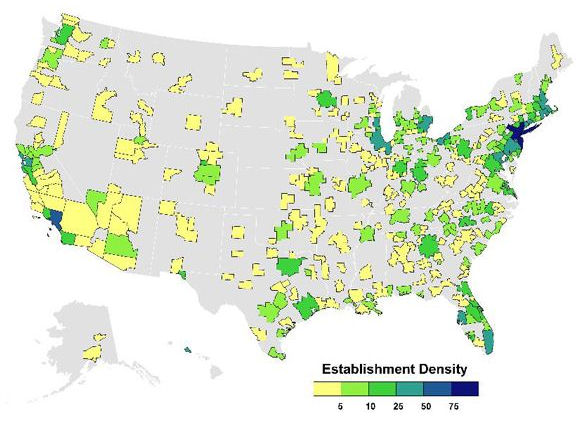In previous posts, I have postulated that some human settlement patterns do more than others to promote creativity and innovation. Following the lead of such thinkers as urbanist Jane Adams, architect Leon Krier and economic geographer Richard Florida, I have suggested that certain urban forms — cul de sac subdivisions, massive skyscrapers — dampen physical mobility and access, thus, the ability of businesses to interact with one another. The ideal urban form would reduce the travel and time cost for people to leave their offices, meet, confer, grab coffee or lunch, meet after hours and have serendipitous encounters. The underlying assumption is that creativity and innovation arise from such interactions.
Drawing upon the work of Jose Lobo with Arizona State University, Florida has mapped the “establishment density” — the number of business establishments per square mile — of the nation’s metropolitan statistical areas. (Read his blog post here.)
 Not surprisingly, New York has the highest number of business establishments per square mile (79) among the country’s 20 largest MSAs, with San Francisco coming in third (47.9) and Boston fourth (34.9). Counter-intuitively — think of all those freeways — Los Angeles has the second highest density (68.7).
Not surprisingly, New York has the highest number of business establishments per square mile (79) among the country’s 20 largest MSAs, with San Francisco coming in third (47.9) and Boston fourth (34.9). Counter-intuitively — think of all those freeways — Los Angeles has the second highest density (68.7).
In Virginia, the Washington and Hampton Roads MSAs are of medium business density, while Richmond is below average.
This is all well and good, but is business-establishment density truly correlated with creativity and innovation? While I believe there is a link, I would hypothesize that it is a weak one, and I would readily concede that the case is far from proven. Someone should run a regression analysis to see if there is a correlation between business-establishment density and various proxies for business innovation.
Here’s the problem: Metropolitan-wide averages don’t mean much. To what extent are business establishments clustered within an MSA? For example, the Washington MSA is a large one, but IT/systems integration companies in the region are packed into a geographic sliver, the Tysons-Dulles corridor. If you measured the business-establishment density of that particular industry, it would be pretty darn high. To take another example, the advertising/marketing industry in Richmond is heavily concentrated within a couple of square miles in Shockoe Slip and Shockoe Bottom.
Here’s another critical issue: What is the quality of micro-level transportation connections within a region? How easy is it to walk, drive or take mass transit from one location to another? While the Dulles corridor may be compact geographically, how easy is it to travel from Point A to Point B within the corridor? Does anyone ever walk anywhere? Are the roads perennially congested? Will the construction of the Silver Line make a material improvement to interactivity within the corridor?
This is a fascinating line of inquiry, and an important one. There are only a handful of things that state/local governments can do to foster a culture of creativity and innovation. Fostering optimal human settlements (or creating the conditions where market forces achieve the optimal level) may be a neglected tool. The idea is worth pursuing.



